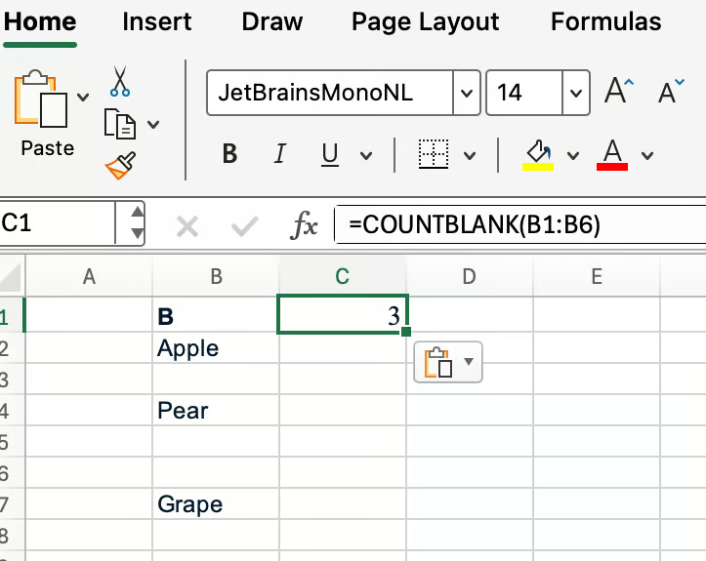Key Takeaways
- Blank cells disrupt data analysis and reporting, creating errors in business calculations and decision-making
- Excel's COUNTBLANK function requires technical syntax knowledge and has limitations with complex data scenarios
- Excelmatic's AI delivers instant blank cell counts with simple language commands, eliminating formula complexity and technical barriers
- Combining Excel knowledge with Excelmatic provides the most efficient approach for identifying data gaps and ensuring data quality
Pesky blank cells can throw off your calculations or reporting. It's a common problem, but thankfully, there are powerful solutions. The traditional approach involves a handy function: COUNTBLANK(). But today, Excelmatic's AI-powered tools offer an even faster, more intuitive way to get the same result.
COUNTBLANK() allows you to count the number of empty cells in any given range, making the data cleanup process much easier. In this guide, we'll walk through how COUNTBLANK() works and then compare it to Excelmatic's modern AI solution to help you choose the best method for your needs.
Method 1: The Traditional Formula with `COUNTBLANK()`
Let's see exactly how Excel's built-in COUNTBLANK() function identifies empty cells.
COUNTBLANK() counts the number of empty cells within a specified range. It focuses solely on cells that are truly blank. If there's nothing in the cell (nothing at all), then it gets counted.
Important: The function counts cells with formulas that return an empty string ("") as blank. However, it ignores cells that appear empty but actually contain invisible characters (such as spaces).
Here's the syntax you'll use:
=COUNTBLANK(range)
Where range is the group of cells you want to check.
For example, if you want to count empty cells in A1 through A10, you'd use:
=COUNTBLANK(A1:A10)
Excel will return the number of truly empty cells in that range. This is a really helpful way to quickly assess the extent of missing data.
What Excel Considers "Blank"
To use the function correctly and avoid mistakes, we have to be careful to differentiate between truly empty cells and those that only look empty.
COUNTBLANK() has a strict definition that can sometimes be surprising:
- A cell with a formula like
=""(which returns an empty string) is counted as blank. - A cell with just a space (
" ") or other invisible characters is not counted as blank. - A cell with a formula that returns a visible value (even
0) is not blank.
If you find that COUNTBLANK() isn't picking up certain cells you think are empty, double-check for hidden characters. You can use functions like TRIM() or CLEAN() to remove them first.
Method 2: The AI-Powered Way with Excelmatic

While formulas are powerful, they require you to remember specific syntax and rules. For a faster, more intuitive approach, you can use Excelmatic.
Excelmatic streamlines data analysis by letting you use plain language. Instead of writing formulas, you simply upload your spreadsheet and ask a question.
For example, to find blank cells, you could just ask:
How many blank cells are in column A?
Excelmatic analyzes your data and gives you the answer instantly, without you needing to type a single formula. This is especially useful for business users who need quick results without technical complexity.
Practical Examples: Formula vs. AI
Let's put both methods into practice to see how they compare.
Example 1: Counting Blanks in a Range
Suppose you have this data in column B and want to find out how many entries are missing.

With the `COUNTBLANK` Formula
To count the number of truly blank cells in B1:B6, you would use this formula:
=COUNTBLANK(B1:B6)
Excel returns 3, since cells B3, B5, and B6 are completely empty.
With Excelmatic
- Upload your Excel file to Excelmatic.
- Ask the question in the chat box: "Count the blank cells in the range B1:B6."
- Excelmatic will instantly return the answer: 3.
The Excelmatic approach gets you the same result, but you don't have to remember the function name or syntax. You just describe what you need in plain language.
Example 2: Calculating Completion Rate
Now, let's look at tracking task completion. Imagine you have a list of 100 tasks in column C, with blanks indicating incomplete tasks.

With a Formula
To calculate the completion rate, you could combine COUNTBLANK with some basic math:
=((100-COUNTBLANK(C2:C101))/100)
This formula subtracts the number of blank (incomplete) tasks from the total, then divides to get the completion percentage.
With Excelmatic
Simply upload your file and ask a more direct question:
What is the completion rate for the tasks in column C, where blank cells mean the task is incomplete?
Excelmatic understands the context and performs the calculation for you, providing the final percentage without you needing to construct a multi-step formula.
`COUNTBLANK()` vs. `COUNTA()` and `COUNTIF()`
It's helpful to know how COUNTBLANK() compares to similar functions.
COUNTA()counts all non-empty cells.COUNTIF()counts cells based on specific criteria (e.g.,COUNTIF(A1:A10,"Pending")).COUNTBLANK()is focused only on totally empty cells.
Choosing the right function is key. But this is another area where Excelmatic shines. With Excelmatic, you don't need to decide between COUNTBLANK, COUNTA, or COUNTIF. You just state your goal:
- "Count empty cells in column A."
- "Count non-empty cells in column A."
- "How many tasks are marked 'Pending' in column A?"
The AI handles the underlying logic for you, making it perfect for business users who need quick answers without technical expertise.
Limitations and Quirks of `COUNTBLANK()`
While reliable, COUNTBLANK() has a few limitations that are worth noting:
- It can't natively check non-contiguous ranges (like A1:A10 and C1:C10 in one formula). You have to sum multiple
COUNTBLANK()calls:=COUNTBLANK(A1:A10) + COUNTBLANK(C1:C10). - It only works with ranges, not arrays.
Here again, Excelmatic provides a simpler path for business analysis. You can ask about multiple ranges in a single prompt:"Count the total number of blank cells in columns A and C."
Conclusion: Which Method Should You Use?
COUNTBLANK() is a versatile and essential function that deserves a spot in your Excel toolkit. Learning to use it is a great way to build your spreadsheet skills.
At the same time, Excelmatic represents the future of data analysis for business professionals. It handles the complexity for you, allowing you to get answers and insights faster and more intuitively.
- Use
COUNTBLANK()when you're comfortable with formulas and want to build manual checks into your spreadsheets. - Use Excelmatic when you want to get fast answers without worrying about syntax, analyze data across multiple ranges, or simply prefer a more conversational approach to your work.
Ultimately, both methods will help you find those pesky data gaps. For business users who need quick, accurate results without technical overhead, Excelmatic provides a revolutionary approach to data quality analysis.
Ready to simplify your data gap analysis in Excel?
Start using Excelmatic today and experience instant, AI-powered blank cell detection.






